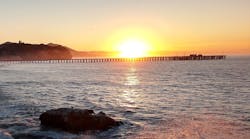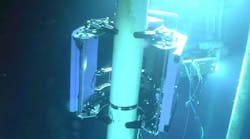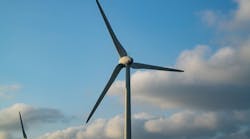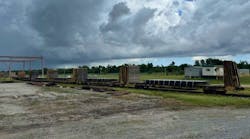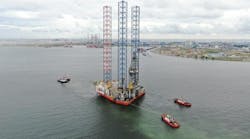Norway softening license cost, terms
Fifteen companies have nominated 34 blocks or partial blocks to include in this year's Norwegian North Sea licensing round. The area covered stretches from Farsund at Norway's southern tip up to the 62nd parallel, the sector's northernmost limit. Bids must be received this fall, with awards expected around the end of the year. In future, acreage off Mid-Norway will also be made available more frequently. Under proposals newly put forward by the government, rounds will be held here every two years, and companies will be invited to apply in groupings of their own choice.
The government also wants to simplify and reduce the cost of applications for North Sea licenses. One proposed solution involves abolishing the current requirement for bidders to buy seismic datasets from the Norwegian Petroleum Directorate (NPD). Developments could also be accelerated if another proposal is implemented, allowing the Oil & Energy Ministry to approve development projects costs up to NKr 10 billion. Currently, parliament has to give clearance for schemes valued at NKr 5 billion or above, which can prolong the approvals process by six months. Also, terms for new entrants may be eased, allowing participation by foreign would-be licensees such as Denmark's DONG and Gaz de France.
Aker Maritime has tested this new spirit of openness by filing a joint application with Germany's RWE-DEA for the 35/3 license in the North Sea. The block contains a gas field discovered 85 km offshore in 1980, but subsequently relinquished as being too marginal. Aker, however, claims to have new solutions to make the field economic. If the application is approved, the partners would drill one test well on the field next spring, which could be followed by a development plan in 2002 and initial production in 2004. This would involve subsea wells tied back directly to a processing plant onshore, with the gas then moved to mainland Europe through the North Sea trunkline system. RWE-DEA would be the operator, with 51% of the license. Aker's previous attempts to operate on the Norwegian shelf have been rebuffed, due to perceptions over its limitations as an engineering contractor.
More government flexibility may be needed, with spending in Norway's offshore sector likely to plummet by one-third next year to NKr33.6 billion, according to Statistics Norway (SSB). This would also amount to less than half the 1999 total of NKr71.4 billion. SSB forecasts that field development will be hit hardest, with investment sliding to NKr13.6 billion next year from NKr22.7 billion this year, and exploration spending slipping to NKr3 billion in 2001 from NKr4.8 billion .
Corrib development moves closer
Gas reserves in Ireland's Slyne Trough could be higher than expected, following Enterprise's latest appraisal success on the Corrib Field. Well 18/20-3, drilled in the northern part of the reservoir by the Sedco 711 semisubmersible, tested at to 60MMcf/d through a 1 1/4-in. choke. Gas was encountered in Sherwood sandstones, with a TVD for the well of 3,790 meters.
According to analysts Wood Mackenzie, Corrib was thought to hold around 1 tcf recoverable reserves. The reservoir lies within a large anticlinal structure with a four-way dip closure. Well 18/20-3 has been suspended as a future producer, with a further appraisal well probably underway by now. Enterprise and its partners Statoil and Marathon are close to sanctioning development, which would be western Ireland's first. The field, in 350 meters water depth, will likely be drained through six subsea wells exporting through an 80 km submarine pipeline to a gas terminal in County Mayo. First gas could be delivered in 2003.
In the Celtic Sea off southern Ireland, Prov-idence Resources is appraising an old Gulf Oil discovery called Helvick in Block 49/9, using the semisubmersible Ocean Nomad. A favorable outcome from the 70-day campaign could also trigger development here late this year. The field has been neglected for some time due to its perceived sub-economic status.
Shell sale sparks Shetland re-alignment
Shell is easing up on its West of Shetland commitments, following deals with Marathon and Austria's OMV. The latter is acquiring 15% of Shell's interests in blocks 204/27a, 28 and 29b, all operated by BP Amoco. 204/28 includes the Vrackie prospect, which was drilled by the partners this spring.
Marathon's is a more complex trade-out; it will cede its 37.5% share in the Sakhalin Energy Investment Company in exchange for Shell's 28% in the Foinaven Field, plus royalties on various Shell production operations in the Gulf of Mexico. Foinaven was the first oilfield to be developed west of Shetland, via a combination of subsea production manifolds, water and gas injection systems that are all hosted by a leased FPSO.
Recently, BP Amoco brought onstream Foin-aven's first satellite, the 10 million bbl T35 which is a single-well development. A more major undertaking is in prospect next year when the partners tackle Foinaven East, thought to hold 120 million bbl. Further oil pockets are waiting to be tapped from various other compartments of the reservoir.
Marathon has targeted the Shetlands as a new growth area in Europe, following the decline of its other operated assets in the UK North Sea (Brae) and southern Ireland (Kinsale). Shell considered Sakhalin more critical to its international growth plans. Foinaven represented 3% of its UKCS reserves.
Conoco also has swelled its Atlantic Margin inventory through buying Norsk Hydro's UK oil and gas portfolio for $540 million. Hydro got saddled with these interests last year when it acquired the ailing Saga Petroleum. Saga had been active particularly in Irish frontier blocks, but the key gains for Conoco are additional stakes in the Alba and Britannia fields, which it respectively operates and co-operates with Chevron. Net reserves to Conoco from this package are 113.1 million boe.
Snadd outcome suggests gas play
Mid-Norway's latest exploration well has delivered gas, but operator BP Amoco Norge would not say how much. Gas was encountered in Upper Jurassic sandstones on the Snadd prospect, situated 17 km south of the Skarv oil and gas field. Here BP Amoco plans a further appraisal well later this year. According to the NPD, Skarv contains 115 million bbl of oil and 29.9 bcm of gas, although the latest discovery suggests the area is more gas prone. Snadd was drilled by the West Navion drillship in 417 meters water depth.
Norsk Hydro will shortly submit development plans for Vale in North Sea block 25/4, with a view to a production start next year. This is a small field containing 2.5 bcm of gas and 22 million bbl of condensate, which would be tied back subsea to Hydro's Heimdal processing facility. Hydro also wants to exploit gas from two other Heimdal satellites, Byggve and Skiren, partly for injection into the heavy oil Grane reservoir, which is due onstream in 2003.
